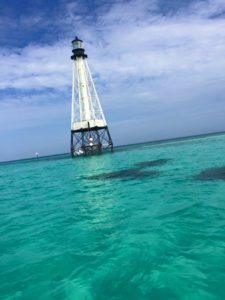 From Carysfort Reef off Key Largo to Sand Key in the Lower Keys, the future of five of the six Florida Keys lighthouses that once kept ships from crashing into the Florida Keys’ coral reef is uncertain.
From Carysfort Reef off Key Largo to Sand Key in the Lower Keys, the future of five of the six Florida Keys lighthouses that once kept ships from crashing into the Florida Keys’ coral reef is uncertain.
The U.S. Coast Guard, which oversees the lighthouses, has declared Carysfort, Sand Key, as well as Alligator Light off Islamorada, Sombrero Light off Marathon and American Shoal off Sugarloaf Key in the Lower Keys, “excess,” meaning they are no longer needed.
This means the General Services Administration, which manages procurement and real estate for the federal government, is looking to unload the historic sites for free to either a non-profit agency or to another government entity, Adam Rondeau, regional public affairs officer for the GSA, said in an email this week.
“GSA understands that lighthouses are an invaluable part of America’s maritime heritage and cherished by their local communities,” Rondeau said.
If no agency or non-profit wants the lighthouses, the GSA will sell them through a public auction, said Rondeau.
“The disposition of these lighthouses will be conducted in accordance with the National Lighthouse Preservation Act,” Rondeau said.
“Recognizing their cultural, recreational and educational value, the stewardship of these historic lighthouses can be transferred at no cost to other government entities or to non-profit organizations. If no steward is identified through this process, the General Services Administration can conduct a public sale of the light station.”
The sixth lighthouse off the Keys, Fowey Rocks, built in 1878, is maintained by Biscayne National Park.
Although they’re being offered for free, maintaining 150-plus-year-old lighthouses is a highly costly, labor-intensive endeavor. And, unlike most lighthouses, like Cape Florida Lighthouse on Key Biscayne and the St. Augustine Light Station, which were built on land, the Keys lighthouses are in the Atlantic Ocean, bolted to the coral reef.
That means an added level of expertise and funding from anyone looking to take over their care.
The GSA has not yet issued a “notice of availability” for the lighthouses, but there is a lengthy process that involves the Coast Guard, the National Parks Service and the Department of Interior before they would be put up for auction.
“Whether it’s at no cost or through an auction, any party acquiring a historic lighthouse through this process is bound by the preservation guidelines set by the National Historic Lighthouse Preservation Act Historic Covenant and the rules and regulations of the Florida Keys National Marine Sanctuary,” Rondeau said.
Already, one man, Islamorada artist Larry Herlth, whose built-to-scale lighthouse replicas can be seen throughout the Keys in front of businesses, banks, and restaurants, as well as at the entrance to the city of Marathon, is forming a non-profit to take over at least one of the lights — Alligator Reef.
“The reason I feel we need to save these lighthouses is that number one, they are a major part of our maritime history of the Florida Keys,” Herlth, 58, also known as “Lighthouse Larry,” said Thursday. “They are the reason we enjoy the Overseas Highway.
“Until 1880, when the last one was put in on the end of Cudjoe Key, Congress would not make Key West a port of entry because of how dangerous the reef line was.”
After American Shoal Light was built and Congress subsequently voted to make the Southernmost City a point of entry for shipping, Henry Flagler, “seeing dollar signs,” began building his famous Overseas Railroad in 1905, Herlth said.
Completed in 1912, much of the railroad was destroyed by the Labor Day hurricane of 1935.
“Congress then took it back and created the Overseas Highway that we enjoy today,” Herlth said.
Herlth, an avid swimmer and cyclist, is the founder of the annual Swim for Alligator Lighthouse 8-mile open-water race each September, aimed at raising awareness for the lighthouse and money for student scholarships. This year, the race attracted more than 350 participants.
Kayakers escort swimmers around Alligator Reef Lighthouse during the Swim for Alligator Lighthouse on Saturday, Sept. 15, 2018, off Islamorada. The open-water swim competition in the Florida Keys attracted more than 350 entrants who were divided into single and group divisions.
“It would make it quite difficult to have the event if there was no lighthouse there,” said Herlth.
Alligator and the other lighthouses dotting the archipelago hold a unique value to many, and should not be abandoned to rust into the sea, Herlth said.
“As a lifelong resident of the Florida Keys and growing up around them, I could not imagine what weekends and holidays would be without the lighthouse and hanging around with friends around it,” Herlth said. “We also need to consider the hundreds of families in the Keys that have sprinkled ashes of loved ones around these structures. I hope Alligator is still there when my ashes need to be sprinkled.”
“They mean so much more than people realize. Please, let’s save them.”
Alligator Light off Islamorada is one of the most iconic images associated with the Florida Keys.
BY DAVID GOODHUE dgoodhue@flkeysnews.com
Source: Miami Herald
To view more of our Blog articles: Please visit our Blog

